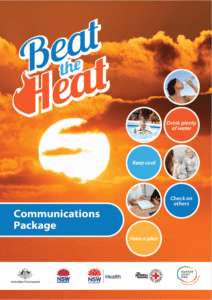Beat the Heat – Heatwave Communications Resources

Heatwaves kill more Australians than any other natural disasters, and the frequency and intensity of heatwaves in Australia is increasing. Our Beat the Heat resources have been refreshed for 2023 to raise awareness of the simple steps that can be taken to reduce the impact of heatwaves on our health.
The Package offers a suite of tailored communication resources, adapting existing messages into various formats to engage different “at risk” communities and address key issues and impacts. This includes medication impacts, rural and isolated communities, the elderly and people with a disability, and families with young children. This package has been developed based on the most current NSW Health Beat the Heat resources. They are provided in a format that makes it easier for councils to use when communicating to their communities.
Beat the Heat Posters, Flyers, and Planning Guide:
Coastal & Estuary Communications Support Package

Coastal communities are impacted by various coastal hazards; erosion, inundation, storms and sea level rise; the severity and frequency of which are increasing due to climate change. Managing these impacts consumes significant council and agency resources and is generally done on a site-by-site or council-by-council basis.
The Coastal & Estuary Communications Support Package provides a resource for Councils of the Hunter and Central Coast to use to educate and create community awareness of coastal hazards and impacts within the region. The Package provides consistent messaging and a regional-scale focus on coastal hazards and impacts in the Hunter and Central Coast Region; however, the materials can be interchangeable and localised by individual Councils where necessary.
The Package is based on the Act on Adaptation Survey report: Creating coastal wise communities (DPE 2022), which collected responses from over 900 community members in the Region, and participating Councils have provided input throughout development of the Package.
The Coastal & Estuary Communications Support Package includes template key messages, frequently asked questions, factsheets, an image library and social media content along with guidance for Council officers utilising the Package. We have included both designed examples as well as plain text content, and Councils are encouraged to adapt whichever materials are most appropriate for the intended use and audience.
Designed resources are included in the Coastal & Estuary Communications Support Package linked above and can also be downloaded here.
The Package is based on the Act on Adaptation Survey report: Creating coastal wise communities (DPE 2022), which collected responses from over 900 community members in the Region, and participating Councils have provided input throughout development of the Package.
The Communications Package aims to deliver:
- An easy to understand and visually engaging communication package
- Documents that clearly drive education, awareness, and interest on coastal hazards within the community
- Evidence-based resources that will be adaptable to local government authorities including how it impacts their lifestyle, how they use coastal and waterway areas for recreation or livelihood, and how they can get involved in future engagement activities
Act now on Adaptation: Coastal Wise Communities
The Coastal & Estuary Communications Support Package was developed during 2022 as part of the ‘Act now on Adaptation: Coastal Wise Communities’ project. The purpose of the Act Now project was to deliver a proactive evidence-based coastal adaptation communication and engagement resource for the Hunter and Central Coast region and provide a pathway to embed Climate Change Resilience into the Integrated Planning and Reporting (IP&R) Framework of Councils. To find out more about the Climate Change IP&R Package, please visit the project page.
For more information on the Act now on Adaptation: Coastal Wise Communities project, please contact Anna Flack at annaf@hunterjo.com.au.
This project has been proudly funded by the New South Wales Government with assistance from Local Government NSW.







